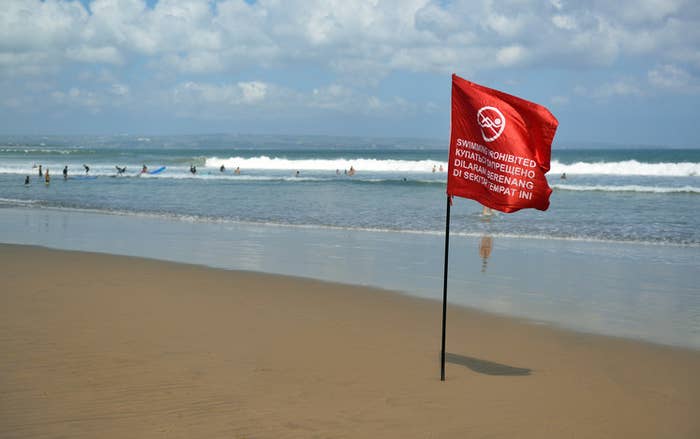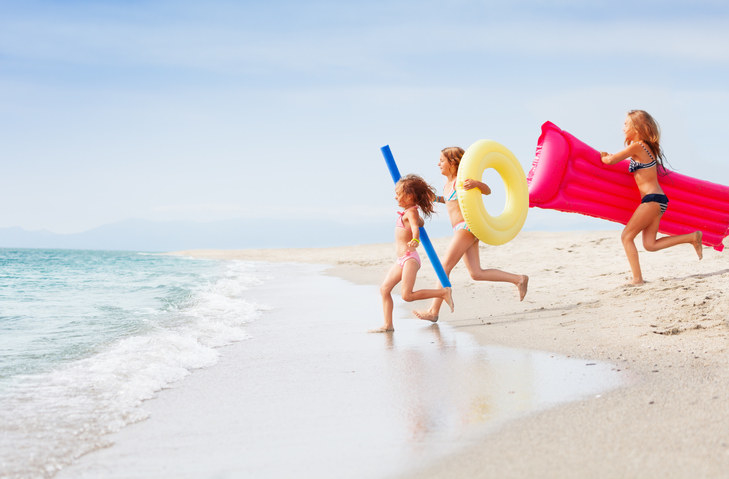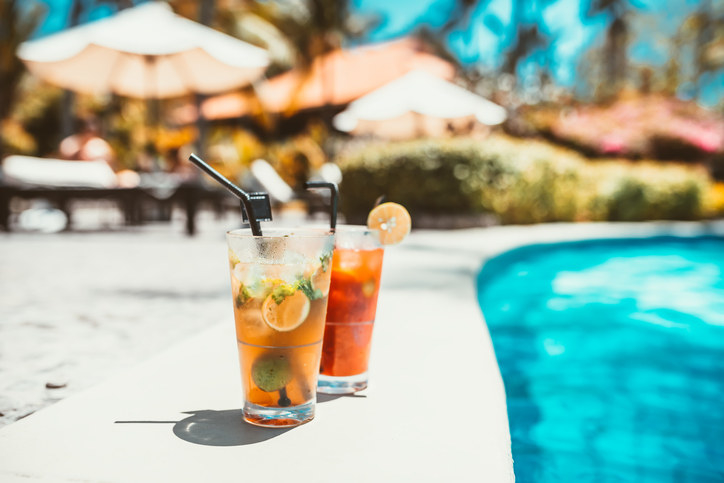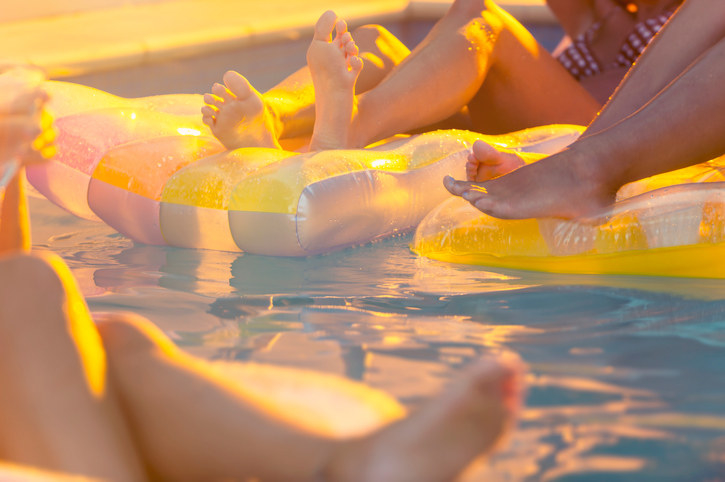Drowning IRL often doesn't look anything like it does in the movies.

Drowning isn't always obvious. In fact, it's often quiet and quick — and sometimes happens in less than a minute or two. People who are drowning may not splash, shout, or make any sound at all.
"When you see a Hollywood film, in a movie, the arms are flailing, and there's all of this splashing that looks like someone needs help," Dr. Alison Tothy, told BuzzFeed News.
The reality is more subtle, said Tothy, who is a pediatric emergency medicine physician at the University of Chicago in Illinois.
That means it's super important to know what it looks like because the person who is drowning won't be physically able to tell you they need help.
People who are drowning sometimes look like they are trying to climb an invisible ladder in the water.
A drowning person's head may be low in the water, even below the waterline, and they will tend to bob up and down, gasping for breath, according to the American Academy of Pediatrics (AAP).
Their eyes may be closed, or glassy and unfocused, and the head is often tilted backward, with hair plastered across their forehead. Because they can't breathe, the person who is drowning is physically unable to call for help.
"They sink a little bit, they come to the surface, they stretch their neck out, gasp for air and then go back under the surface again," Tothy said.
Although their arms may be moving, the person's body is usually in an upright or vertical position and they are unable to kick their legs or move in a particular direction. It can look a little like they are trying to climb a ladder in the water.
"There might be a little bit of splashing, but often drowning victims don’t have enough energy or ability to get their hands above the water to make a big splash," said Tothy, who is a member of the AAP Committee on Injury and Poison Prevention. "It's really those subtle signs of distress you are looking for."
Little kids are at highest risk, but it can happen to anyone.

About 10 people die every day in the US from drowning, and roughly three of those are children under 14. For every drowning death of a child under 14, another five go to the emergency room for nearly drowning, which is also known as a nonfatal drowning.
Children 4 and under are at the greatest risk, and in fact, it's the number one cause of death in youngsters in that age group after birth defects.
Overall, about 80% of drowning-related deaths are in males.
Babies and toddlers can drown in a couple of inches of water.
This is true even in kiddie pools, bathtubs, or any body of water, including buckets of water left over after mopping.
"Toddlers and mobile 1-year-olds or 2-year-olds are top heavy — their heads are proportionally bigger than their bodies," Tothy said. "They can lean over to look in a bucket and they can get stuck in the bucket and they don’t have the dexterity and capacity to push themselves up out of the bucket."
"Bathtubs can be extremely dangerous as well, you can’t leave your kids even in a couple inches of water," she added. "It happens in a second."
Overall, close supervision is essential for young children, Tothy said.
"Just like you shouldn’t turn your back on your little baby when you are changing their diaper on the changing table because they flip so quickly, toddlers and little kids are quick and fast and they can very quickly get into trouble," she said. "They can end up in the pool and they can’t swim, or they can crawl under the cover of the pool, or they can breach the gate that you think is locked — so you need to keep eyes on your kids at all times."
People who are black are at way higher risk of drowning than whites.
The risk is highest for kids ages 5 to 18. In that age group, the chance of drowning in a swimming pool is 5.5-fold higher in blacks than whites. And it's even worse for children ages 10 and 11, where the drowning rate is 10 times higher in blacks than whites, according to the Centers for Disease Control and Prevention (CDC).
A bunch of factors are playing a role here, including less access to and use of swimming pools and swimming lessons, according to the YMCA, which found that 64% of black and 45% of Latino children couldn't swim, compared with 40% of whites.
The lack of swimming skills can be passed from generation to generation. Only 13% of children will learn how to swim if their parent can't swim, according to a USA Swimming Foundation study.
Swimming lessons are great, but they aren't a 100% guarantee of protection — particularly for little kids.

The CDC notes that swimming lessons may reduce the risk of drowning in children ages 1–4. But in general, the AAP recommends that swimming lessons start at age 4.
But don't assume that because your young child has had swimming lessons, that they need less supervision.
"Swimming lessons in little kids should not reassure parents that they are capable of saving themselves," Tothy said.
Kids can quickly get into trouble if they fall into water, and that may happen faster than you think. And they are super curious and can be faster and more agile than you expect, she added.
"Things you think they couldn't scale, they can scale in a minute," she said.
There are a bunch of things you can do to help reduce the risk of drowning.
Besides not knowing how to swim or a lack of supervision, several other factors can increase drowning risk. That includes inadequate barriers or fencing to keep children from pools (4-sided fences that completely enclose a pool are better than 3-sided fences that attach to the home); drinking alcohol while swimming, and not using life jackets, particularly while boating. There are over 300 boating-related deaths each year, according to the CDC, and half of those could be prevented if people used life jackets.
You also shouldn't rely on air-filled or foam toys instead of life jackets.
"For parents, it's supervision, knowing where your kids are, not relying on floaties to keep your kids afloat, not leaving them to go answer the phone, knowing that gates and fences don’t protect your kids from getting in the water, and that swimming lessons aren’t the end all, be all for protecting your kids from drowning," Tothy said.
Teens and adults should avoid alcohol when swimming and pay attention to posted warning signs at the beach.
"Whatever flag they put up that says the riptide is bad or no swimming allowed, pay attention to those, they are there for a reason," she said. "They are there to keep you and your children safe."
"Teach your teens to pay attention and respect these rules as well," she advised.

There's something called secondary drowning, and it's a real thing.
Secondary drowning can happen if someone — either a child or adult — aspirates water into their lungs, which causes problems hours or even a day or two later.
"You can get inflammation and problems — difficulty breathing, cough, respiratory difficulties — later on as a result of chemical irritation of the water, not to mention the bacteria, if it was a river or lake," Tothy said. "So secondary drowning is within 24 to 48 hours."
The symptoms of secondary drowning are a worsening cough and difficulty breathing.
"It looks like they are working hard to breathe, and they have this cough that won’t go away," she said.
It's pretty rare, she said. However, it's worth calling your doctor or (if your doctor isn't aren't available) going to an emergency room, if the symptoms are worrisome.
"I wouldn’t tell parents to stare at their kids overnight after they swallow some water in the pool, but if they start to have an increased cough or any trouble breathing, then they should have it in the back of their mind," she said.
There's also something called dry drowning.
Dry drowning can occur when a little bit of water triggers an airway spasm that causes difficulty breathing.
"It’s not that your kid was submerged under water and took a ton of water in," Tothy said.
She added that the secondary drowning is what people should be more aware of.
"Dry drowning can just be water that triggers a spasm in the airway and it causes the airway to close up and impact breathing, and that’s something to worry about, but again it doesn’t happen that often," she said.
Performing cardiopulmonary resuscitation (CPR) helps.
People who are drowning victims are more likely to survive if someone performs CPR, and the quicker the better. Check out the American Heart Association's video on how to do hands-only CPR.

